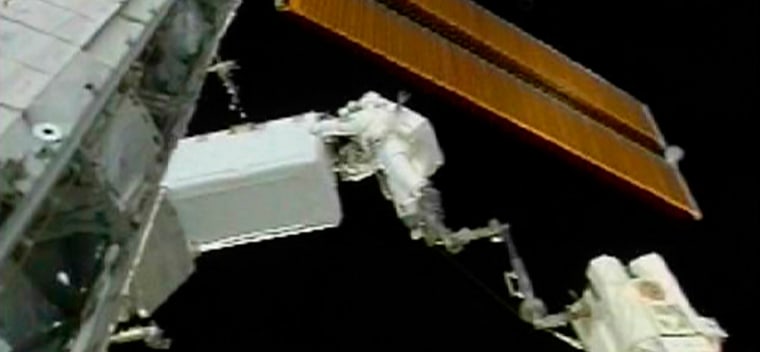Shuttle Discovery's astronauts breezed through their third and final spacewalk Sunday, replacing an empty gas tank at the international space station and collecting a sample of dusty debris.
Spacewalkers Michael Fossum and Ronald Garan Jr. wrapped up their work so quickly that Mission Control threw in some extra chores.
The highlight of the 6 1/2-hour spacewalk, for Garan, was a long ride on the space station's robot arm that swung him 80 feet (24.38 meters) out from the orbiting complex. He carried an empty nitrogen gas tank from one side of the station to the other, then returned with a full tank and plugged it in for use in the coolant system.
With the Earth 210 miles (338 kilometers) below and the space station the equivalent of eight stories away, it was a ride like no other. NASA called it the windshield wiper maneuver. It took Garan over Australia and the South Pacific, over Peru and beyond.
"How's your ride, Ronnie?" Fossum asked.
"Great!" Garan replied.
The two squeezed in some stargazing as Garan rode on the robot arm. Fossum recalled how a schoolboy once asked him once whether he could see the stars during a spacewalk. "Indeed, you can," Fossum said.
Afterward, Fossum returned to a big joint that he inspected during Thursday's spacewalk and gathered some dusty debris on two pieces of tape for analysis back on Earth. The joint turns the solar wings on the left side of the space station toward the sun, like the paddle wheels of a boat.
That left joint is working fine, but the one controlling the solar wings on the right side is clogged with metal shavings and has been used sparingly since last fall. Energy production has been hampered as a result.
NASA wants to learn as much as they can about the joints, in hopes of figuring out why one ended up in such bad shape.
The spacewalkers performed a few more outdoor chores on Japan's Kibo lab, which was installed last week, and hooked up a newly repaired camera elsewhere on the space station.
"Well, fellas, you did an awful lot of good work today. You ought to be very proud of yourselves," shuttle pilot Kenneth Ham called out from inside.
Slideshow 12 photos
Month in Space: January 2014
On Saturday, Discovery crew members Akihiko Hoshide and Karen Nyberg moved Kibo's robotic arm for the first time, slightly maneuvering two of its six joints.
Full deployment of the 33-foot arm will be done after Discovery leaves the station next week. However, it won't be used for any actual work until after the launch into orbit next year of the lab's third and final section — a "porch" for exterior experiments — and a second, smaller robotic arm.
Japanese Prime Minister Yasuo Fukuda spoke to Hoshide and Discovery commander Mark Kelly and congratulated them on Kibo's successful installation.
Kibo, Japanese for hope, was delivered by the shuttle and installed on the space station last week.
Also Saturday, several thermal protective panels on Discovery's right wing that the astronauts had photographed because of some slight pulses in their embedded sensors were given the "all clear," said flight director Annette Hasbrook.
The wing sensors are one of NASA's many safety measures put in place after Columbia was destroyed during re-entry in 2003 as a result of a gashed wing.
Discovery and its crew have two more days at the space station, before leaving Wednesday.

